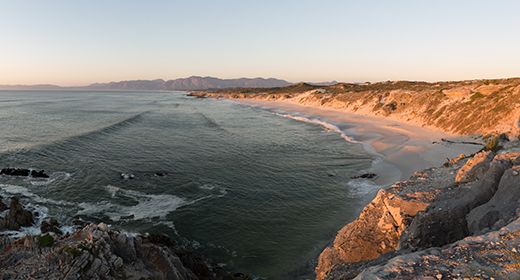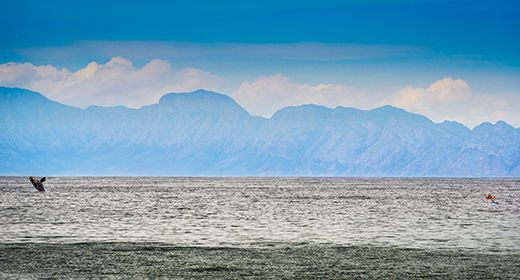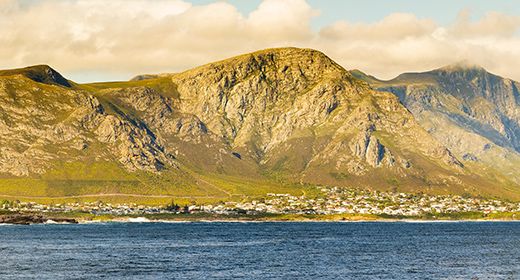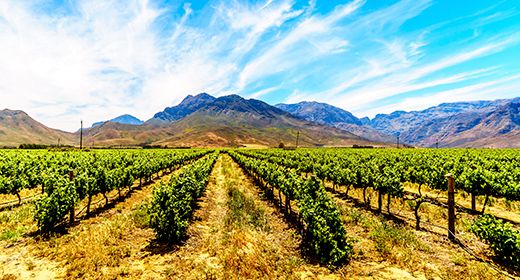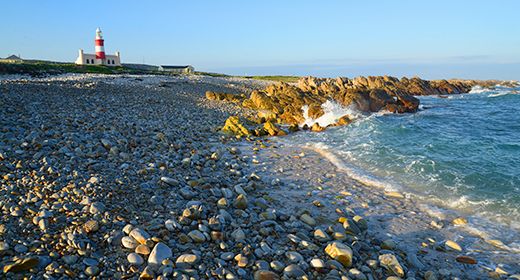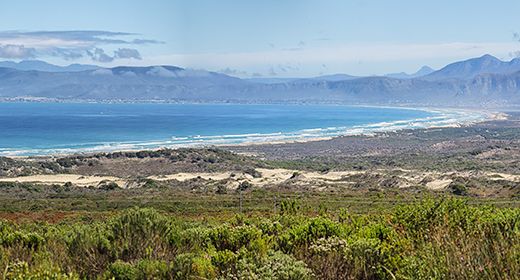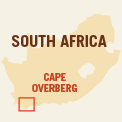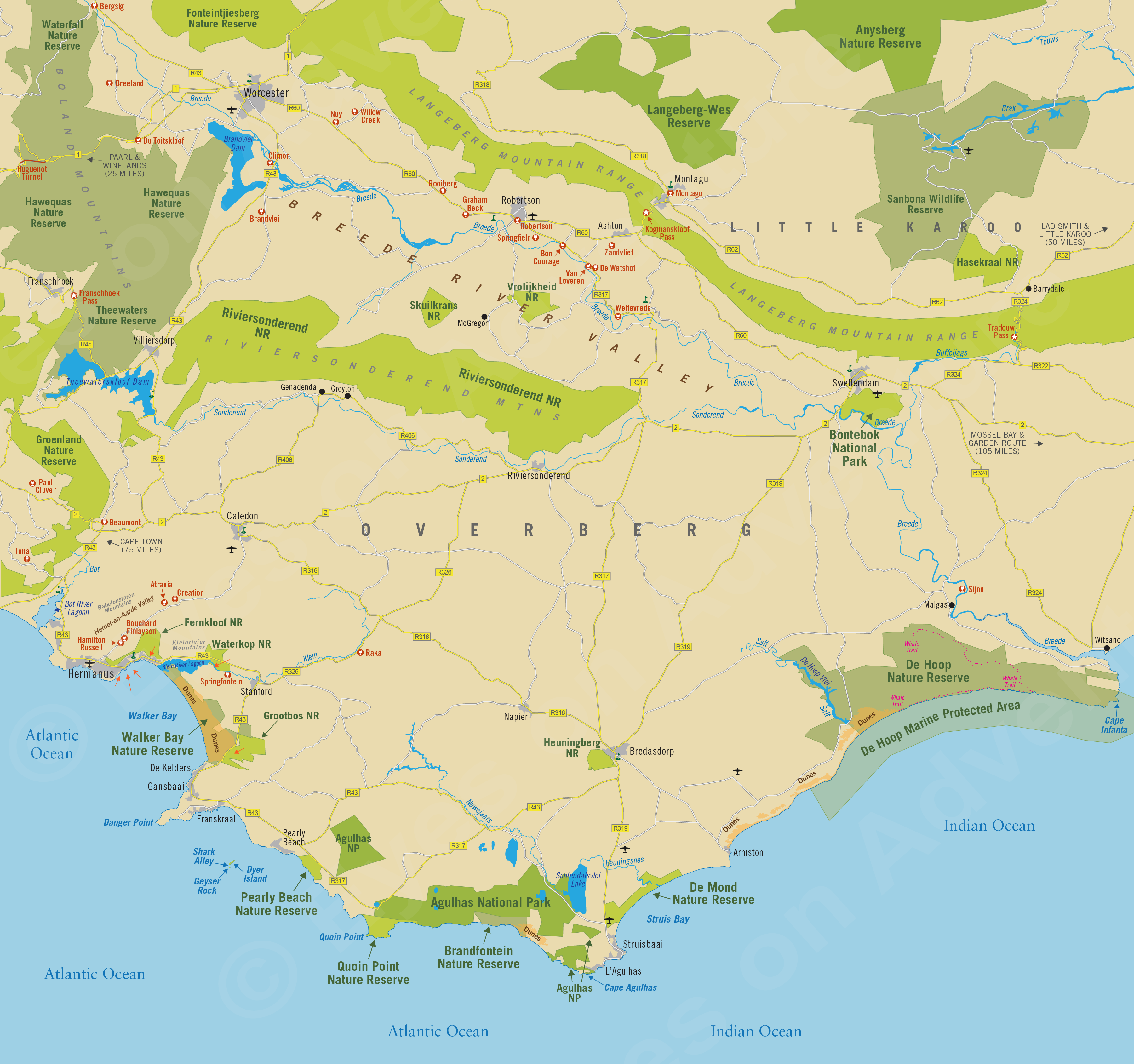Overberg & Whale Coast
(incl. Hermanus, Gansbaai, Agulhas, De Hoop, Breede River Valley, Little Karoo)
Region Links: Cape Peninsula, Cape Town, Cape West Coast, Cape Winelands, Eastern Cape, Garden Route, Gauteng Province, Johannesburg, Kruger Park & Lowveld, Kruger Private Reserves, KwaZulu-Natal, Madikwe, Overberg & Whale Coast, Pilanesberg & Sun City, Sabi Sand Reserve
Highlights
- Visit Hermanus for the best land-based whale watching in South Africa
- Cage-dive with white sharks at Dyer Island near Gansbaai
- Stand at the southern tip of Africa between two oceans at Cape Agulhas
- Hike the 5-day Whale Trail for a spectacular walking-plus-wildlife experience
- Explore the Breede River Valley and sample the regional wines
EOA Recommends: Grootbos Forest Lodge, Ocean Eleven Guest House, The Marine Hermanus, Tilney Manor
The Overberg (meaning 'over the mountain') is the southernmost region on the African continent. It’s a wild and beautiful place offering dramatic contrasts, spectacular diversity and plenty to see and do.
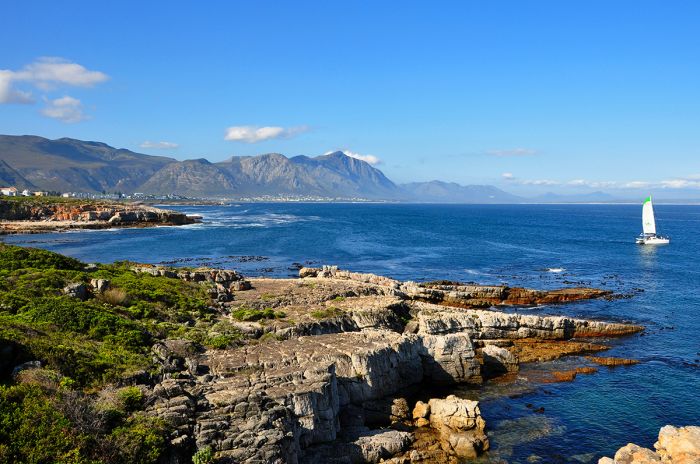
The bay at Hermanus in South Africa's Overberg region
The Overberg’s coastal area is often referred to as The Whale Coast, as its waters are used by Southern Right whales for breeding.
Hermanus is the main attraction here and the town offers superb whale watching, especially from June to November. Offshore is Dyer Island, where epic great white shark viewing in the renowned “Shark Alley” is an adrenaline-filled adventure.
East of Hermanus is Walker Bay with its secluded coastal dunes and Cape Agulhas, the southernmost point in Africa and the dividing point between the Indian and Atlantic oceans.
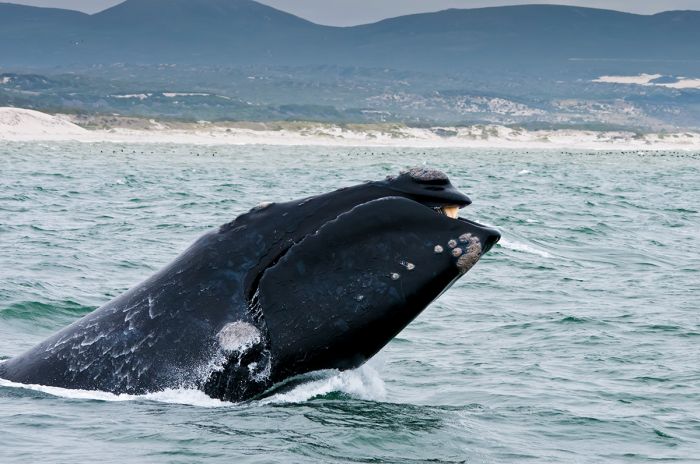
A Southern Right whale breaches off the coast of Hermanus
Further east along the coast is the spectacular De Hoop Nature Reserve, a huge land-and-marine protected area and a World Heritage Site. The reserve offers miles of wilderness with dunes, coastal mountains, fynbos, wildlife, diverse bird life and whale watching. The very popular five-day Whale Trail, is one of the best treks in South Africa.
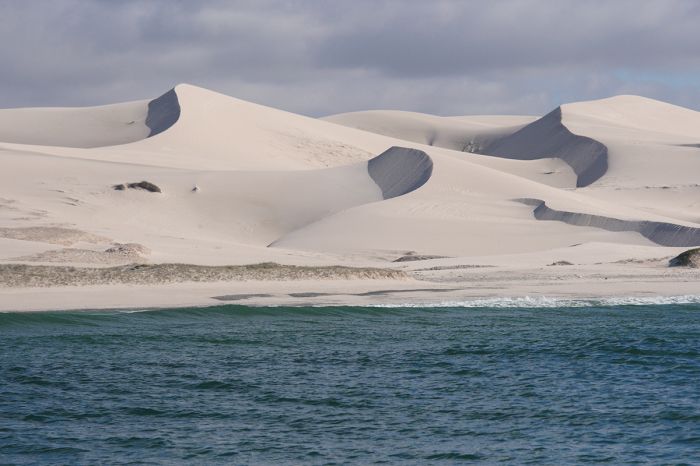
Towering white sand dunes in the De Hoop Nature Reserve
Inland from the coast are wheat fields, sheep farms, windmills, and small, picturesque 18th- and 19th-century towns that are few and far between. Further north and across the N2 road (which leads east to the Garden Route) are the Riviersonderend Mountains and the well-known Breede River Valley, with numerous wine estates and vineyards. Notable towns in the valley include Worcester, Robertson, and Swellendam, plus the Bontebok National Park.
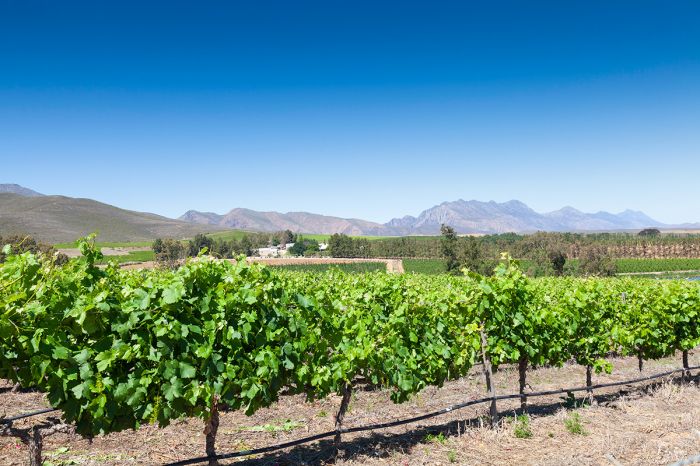
Vineyard in the Breede River Valley with the Langeberg mountains in the distance
North of the Breede Valley are the Langeberg mountains and the western part of South Africa’s Little Karoo region. Here you can visit Sanbona Wildlife Reserve and see Africa’s Big Five (lion, leopard, rhino, elephant, buffalo) plus an incredible diversity of habitats, flora and fauna.
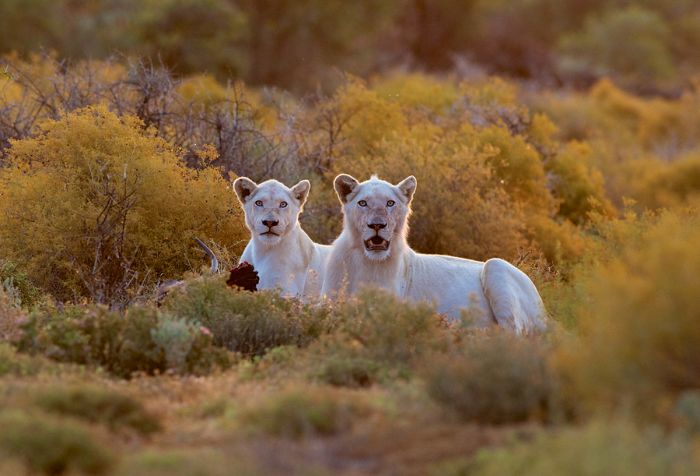
White lions on a kill in the Sanbona Wildlife Reserve
The Overberg is certainly worth a visit if you are visiting Cape Town, the Cape Winelands or en route to/from the Garden Route.
Read More...
Arniston, Bontebok NP, Breede River Valley, Cape Agulhas, De Hoop, Gansbaai, Hemel-en-Aarde, Hermanus, Little Karoo, Montagu, Overberg, Robertson, Sanbona, Sharks, Swellendam, Whale Coast, Wineries-Breede River, Wineries-Hermanus, Worcester
The Overberg and Whale Coast
Located east of the Cape Winelands is a region call the Overberg (Afrikaans for 'over the mountain'). When South Africa's Cape was first colonized by Europeans, the small towns of Stellenbosch, Paarl, and Franschhoek (all in the winelands) were remote outposts and the land beyond this was considered a barren outback... this is the Overberg.
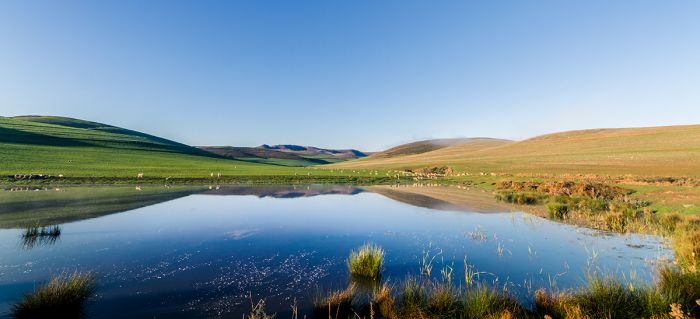
Grazing sheep and Overberg landscape
From Cape Town, there are two driving routes through the Overberg...
The N2 road heads inland through sheep farms, wheat fields, and along the Riviersonderend Mountains (and eventually to the Garden Route coastline further east).
The R43 tracks along the coast and into Hermanus, around Walker Bay Nature Reserve and down towards Agulhas National Park, where the coastal roads terminate. From here on there are no roads that run parallel to the coast, resulting in a wild and undeveloped wilderness that includes the spectacular De Hoop Nature and Marine Reserve.
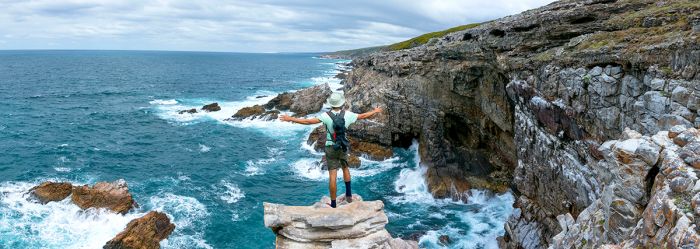
The Whale Coast in the De Hoop Nature Reserve
The Overberg's coastal region is also called The Whale Coast because its offshore waters are used annually as a breeding and birthing grounds by whales, especially Southern Right whales.
Anyone visiting the Garden Route should consider adding some days to their itinerary to explore this diverse and interesting region.
Hermanus
Hermanus overlooks Walker Bay and is considered to have the best land-based whale watching in South Africa. For this reason, it is the main tourist draw in the region. The town is located on a narrow coastal plain backed by the impressive Klein River Mountains and is only 75 miles (120 kms) from Cape Town.
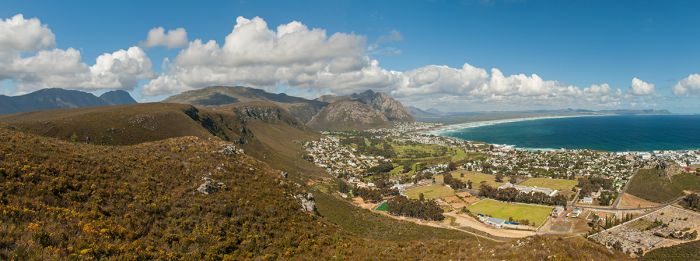
The town of Hermanus with the Klein River Mountains
Founded by settlers in 1855, Hermanus was once a quiet fishing village and fashionable getaway for Capetonians in the early 1900s. Today the town still has a resort feel, but has grown with whale-based tourist revenue. Hermanus offers restaurants, craft shops, good swimming beaches and plentiful lodging. The town can be crowded on weekends and during the summer.
The warm, sheltered waters in Walker Bay attract whales, which start arriving around July to breed and give birth to their calves. All nine of the Southern Hemisphere's whale species can be seen in Hermanus and along the Whale Coast, but southern right whales are by far the most common. Sadly, the name comes from them being the "right" ones to kill, as they have the highest oil and bone content, and they float when dead. All whaling-related activity has been outlawed in South Africa since 1979.
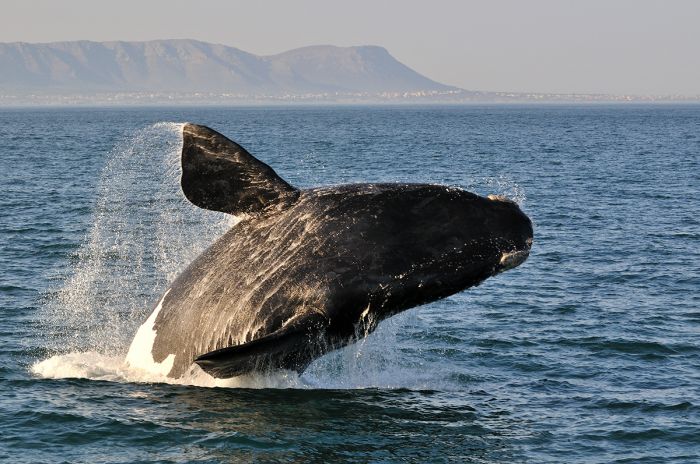
A southern right whale breaches in Walker Bay near Hermanus
The annual Whale Festival, takes place here during the last week of September, with whale-based events all week. Hermanus even boasts an official whale crier (supposedly the only one in the world), who blasts a dried kelp horn to announce sightings during the peak season. July to October is the whale-watching season, with September and October being the peak months for viewing. For those who want to see whales close-up, there are also boat-based whale-watching trips from town.
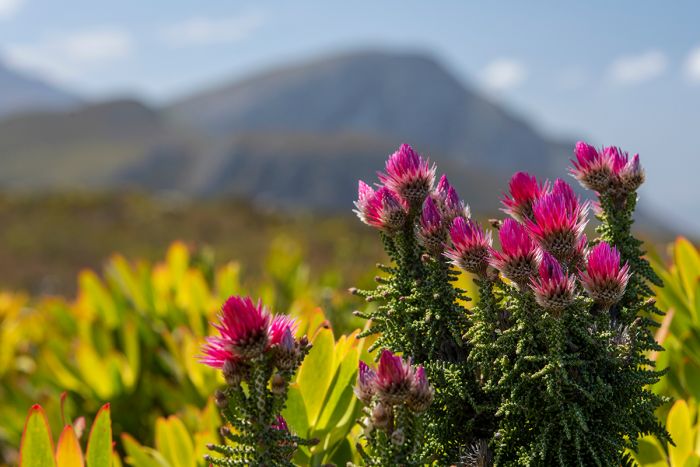
Beautiful wildflowers known as Sewejaartjies, one of myriad fynbos in the Fernkloof Nature Reserve
Just north of town, the Fernkloof Nature Reserve offers mountain hikes along nature trails, with beautiful fynbos vegetation, excellent bird life and spectacular views over Walker Bay.
The Hermanus Wine Route (also called Wine Route 320), boasts some of the country's top wines with grapes grown in the Hemel-en-Aarde Valley just outside town. Located along a 15-mile (25-km) stretch of the R320 road, the route and valley boast numerous wine estates offering notable restaurants and tasting rooms.
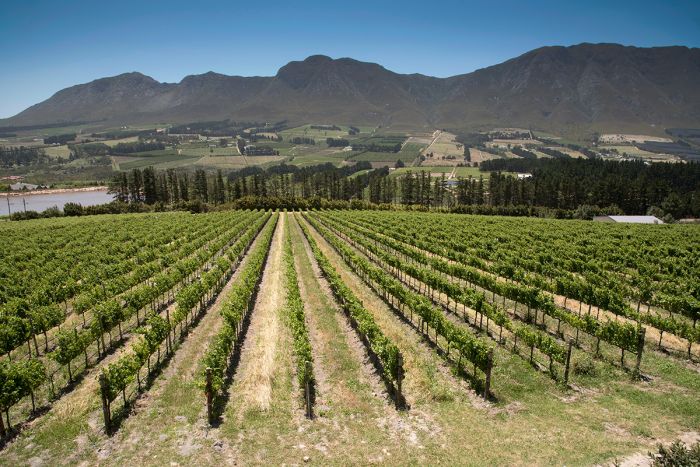
Vineyards in the Hemel-en-Aarde Valley with the Kleinrivier Mountains in the distance
Our Winery Picks - Hermanus / Hemel-en-Aarde Valley
- Atraxia: A contemporary winery with gorgeous mountain views. Excellent Pinot Noir.
- Bouchard Finlayson: Spectacular Pinot Noirs and white blends. Tastings offered. Walks through the fynbos on the estate.
- Creation: Estate known for gourmet food and wine pairings. Restaurant sources local foods. Excellent Syrah and Grenache blends.
- Hamilton Russell: A simple thatch building overlooking a dam. Renowned for Pinot Noir and Chardonnay, which are both world-class. Bring your own snacks and picnic on the lawn.
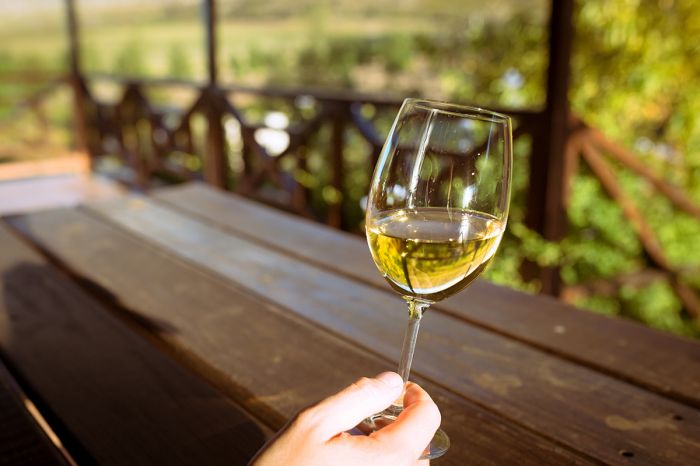
Wine tasting in the Hemel-en-Aarde Valley near Hermanus
Gansbaai and White Shark Safaris
Gansbaai, named for the geese that once nested there, is a small fishing village that has gained tourist popularity for its great white shark safaris.
Dyer Island, located 2.5 miles offshore and a short boat trip from Gansbaai, is a protected wildlife sanctuary and is well-known for providing spectacular white shark viewing. Dyer and its smaller neighboring islet, Geyser Rock, are home to some 40 000 to 50 000 Cape fur seals, around 2 000 African penguins, plus other seabirds that nest there.
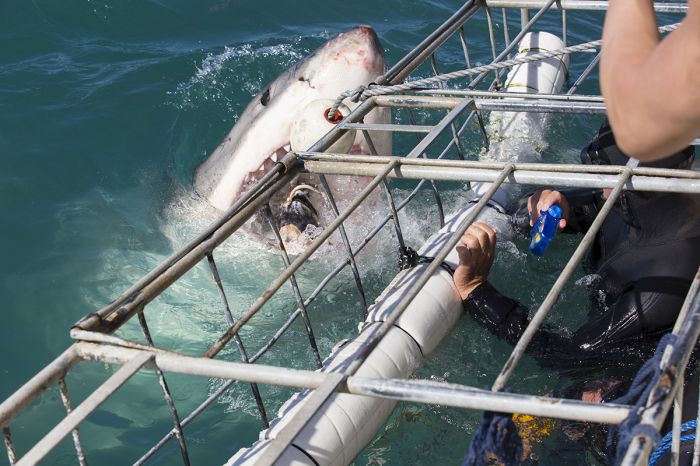
A white shark says hello to the shark cage at Dyer Island
The narrow channel between the two islands is popularly called shark alley, as these waters are the popular feeding grounds for white sharks, which prey on the seals and penguins that venture into these waters looking for food.
Operators in Gansbaai run half-day shark excursions and participants have the option of viewing from a shark-proof cage attached to the side of the boat, which allows for underwater views and photography, or from the deck of the boat. Interesting shark behavior such as breaching and predation are often seen.
Other wildlife is also likely to be seen on the shark safaris, including sea birds and Africa's Marine Big Five (sharks, dolphins, whales, penguins, seals).
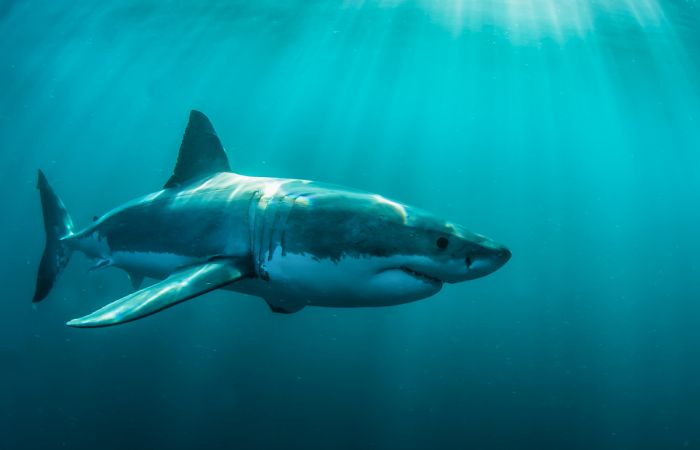
A white shark at Dyer Island near Gansbaai
Agulhas
The shallow and rocky coast running east from Quoin Point to Cape Agulhas has some of the most treacherous waters on the African continent, with strong currents, heavy winds and dangerous swells. These waters have claimed over 150 shipwrecks and 2 000 lives over the years. Owing to the dangerous conditions here, there is no coastal road along this stretch of coastline.
The Shipwreck Museum in the nearby town of Bredasdorp offers a great look at the stories of many of these ships, plus recovered remains that were found offshore over the years.
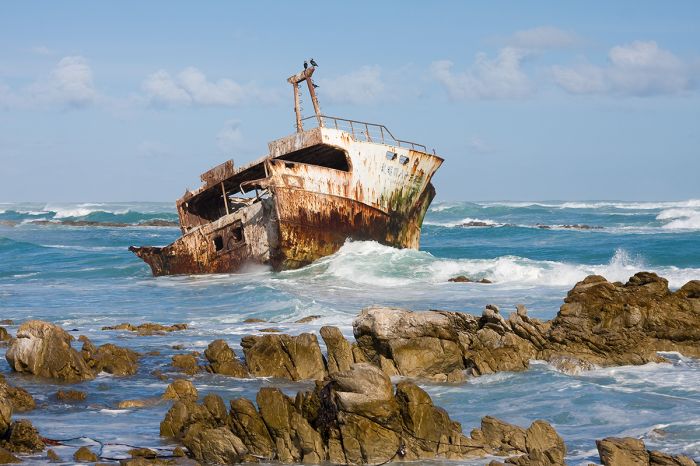
The Meisho Maru wrecked off Agulhas in 1982
Declared in 1999, the mostly undeveloped Agulhas National Park protects the barren, desolate, and lonely promontory that was dubbed Cabo das Agulhas (Cape of Needles) by Portuguese explorers. The coastal plains and shores protected by the park include over 2 000 species of indigenous plants, plus marine life, shipwrecks and archeological sites.
Cape Agulhas is Africa's southernmost point and is rather undramatic, with the tip of the continent trailing off in a gradual, stone-strewn beach into the sea. Agulhas Lighthouse, built in 1849 and the second oldest in the country (after Cape Town's Green Point), is worth a look and can be climbed for a good view. A rock plaque marks the tip of Africa and also declares it as the divide between the Atlantic and Indian Oceans.
Nearby L'Agulhas and Struisbaai are quiet little towns with shops, restaurants, and some accommodations. East of Struisbaai is a seemingly endless white-sand beach with marvelous swimming.
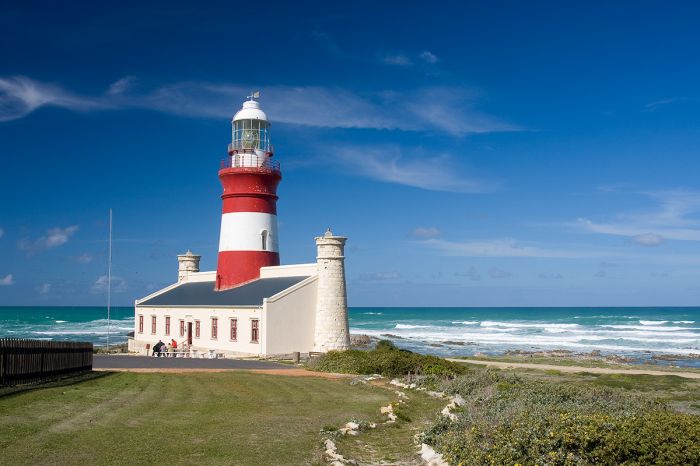
Agulhas Lighthouse, built in 1849
Arniston
Arniston is a small, seaside community named for the East India Company ship of the same name, which wrecked offshore in 1815. Only six of 378 people on board survived. The village is known to locals by its Afrikaans name, Waenhuiskrans (meaning 'wagon-house cliff'), after a huge cave near town which early settlers reckoned was big enough to hold several wagons with their spans of oxen.
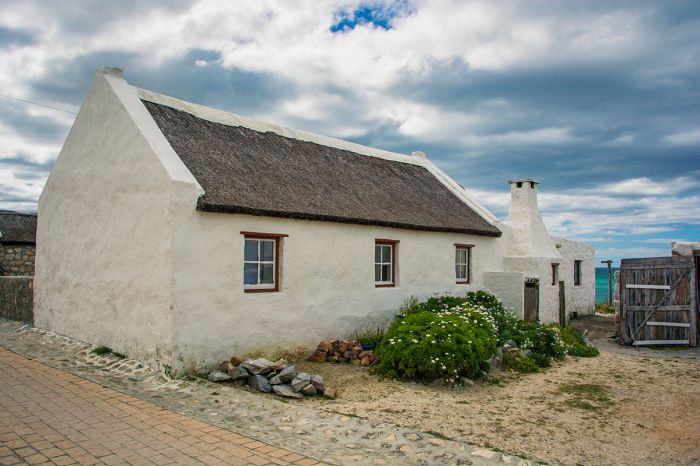
Traditional house on the coast in Arniston, South Africa
Arniston is an unspoiled fishing town, with lime-washed houses and a community of 'coloured' fishermen that still go to sea in traditional boats of the type used in the 19th century. The Kassiesbaai neighborhood, home to many of the fishing families that have lived here for generations, has been declared a National Monument and is worth exploring and photographing.
The beautiful 3-mile (5-km) long, white-sand beach east of town is spectacular, with turquoise seas and shallow (but chilly) waters that are great for safe swimming. The towering white dunes along the beach are something to behold.
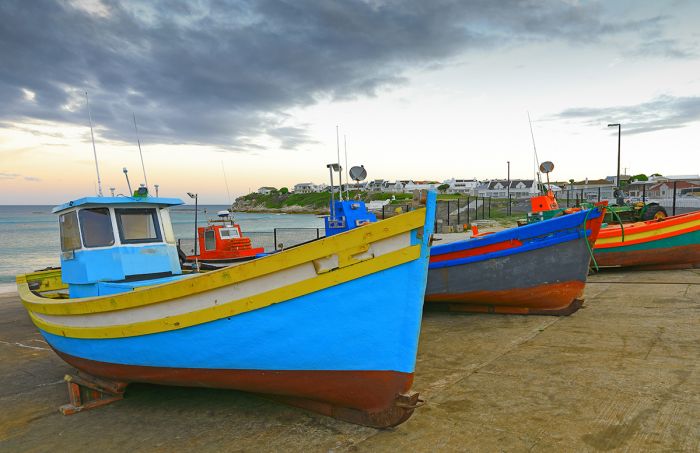
Fishing boats at the harbor in Arniston
De Hoop Reserve
The 139-sq-mile (360-sq-km) De Hoop Nature Reserve protects South Africa's largest remaining patch of coastal fynbos, along with towering white-sand dunes, abundant indigenous wildlife, including Cape mountain zebra, bontebok, eland, and over 250 species of birds.
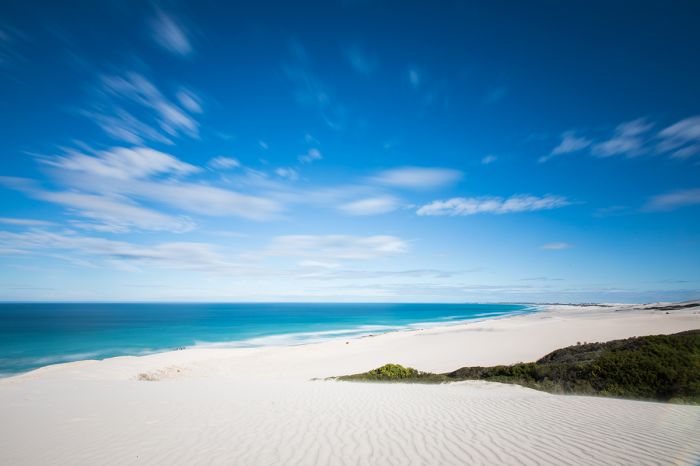
White sand beach in the De Hoop Nature Reserve
The De Hoop Marine Protected Area extends 5 miles (8 kms) offshore and protects myriad underwater life and whale calving grounds. Whales watching season is July to October, with the peak months being August and September.
The reserve is only explored on foot and there are numerous short hiking trails. For a more thorough exploration, the very popular 5-day, 34-mile (55-km) Whale Trail offers one of the best walking plus wildlife experiences in Africa. Due to high demand, the Whale Trail must be booked up to one year in advance. The 'slack-packing' option includes porters to carry additional luxurious food items. Self-catering cottages are used for the overnights.
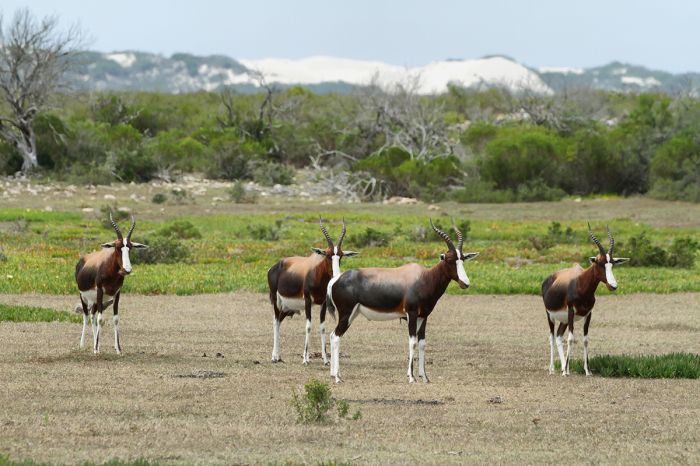
Bontebok antelopes and white sand dunes in the De Hoop Nature Reserve
Breede River Valley
The Breede River Valley covers a huge territory along the Breede River as it flows southeast between various mountain ranges on its way to the Indian Ocean. It's a lovely valley, with spectacular mountain scenery, miles of fruit-producing farmlands and several small towns. The warm and dry summers, combined with wet, but mild winters, makes it near perfect for viticulture and there are wine estates and tasting rooms dotted across the valley. The vines are irrigated from water drawn from the Breede River and the Brandvlei Dam, near Worcester.
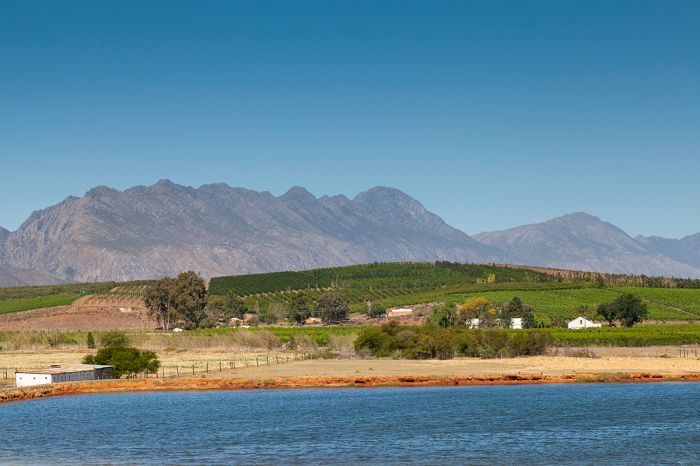
Vineyards in the Breede River Valley near Robertson
Worcester is the largest town in the Breede River Valley and is a mostly unremarkable agricultural town. On the northern side of town is the Karoo Desert National Botanical Gardens, a sister reserve to Kirstenbosch in Cape Town. For the best flowers, visit the gardens from late July to early September. The Worcester Museum offers a glimpse of life on the Karoo frontier from the late 1600s to the late 1800s. The Worcester Valley viticulture sub-region produces mostly lower-grade and bulk-produced wines sold by large cooperatives and makes up about 20% of the country's production.
A 30-minute drive from Worcester takes you to Robertson, another agricultural town. It was founded primarily to service the grape farms in the Robertson Valley sub-region. The soils here are ideal for wine grapes, and the specialties here include Chenin Blanc, Colombard, and inexpensive but drinkables red wines. Robertson Valley makes up about 10% of the country's wine production. Colorful wild flowers are abundant along the roads and vineyards here.
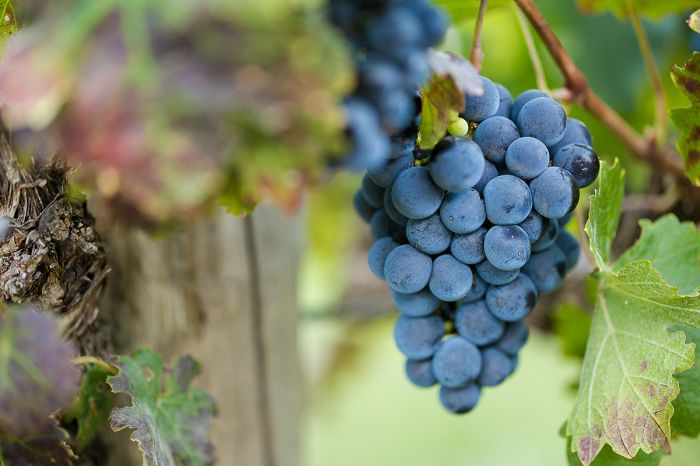
Wine grapes on the vine in the Breede River Valley
Our Winery Picks - Breede River Valley
- Bon Courage: Old homestead along the Breede River. Excellent sweet wines, including Muscadel. Free tastings. Restaurant serves breakfast and light lunches.
- De Wetshof: Beautiful mountain and vineyard views. Flagship Bateleur Chardonnay is great. Over 10 wines including sparking.
- Graham Beck: Lovely modern estate. Sophisticated sarkling wines considered the best in the country.
- Robertson: Good-value wines, especially Chardonnays and Colombards. Free tastings.
- Rooiberg: Great value wines, including Pinotage, Shiraz, Merlot. Estate restaurant serves light lunches and pastries.
- Springfield: Popular estate producing stellar whites, some using wild yeast in style used in Burgundy. Free tastings. No food, but bring your own and picnic.
- Van Loveren: Family-owned estate, relaxed and friendly. Over 60 wines, plus brandy, whisky, beer. Tastings with chocolate, cheese, charcuterie. Good restaurant.
Founded in 1745, Swellendam is South Africa's third-oldest town and lies in the foothills of the beautiful Langeberg Mountains. In its early days, the town was an the last rural, but civilized outpost for the Dutch East India Company before one headed into the mostly unexplored interior. Many of the original Cape Dutch style homes and other buildings have been beautifully restored. The interesting Drostdy Museum is a collection of historic buildings and restored gardens and is worth a visit. The town is a common stopover along the N2 road to or from the Garden Route.
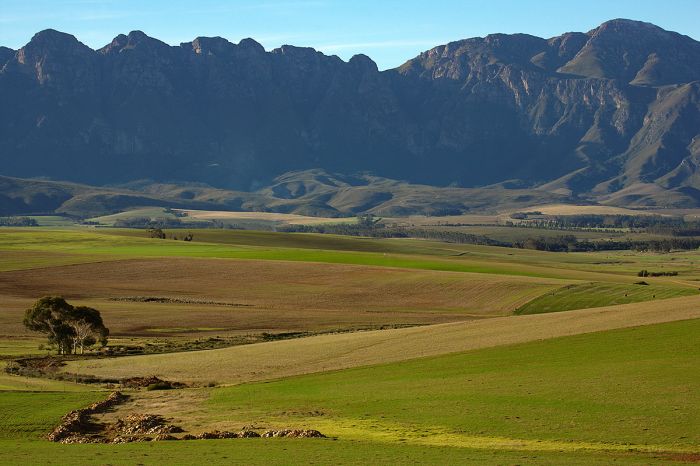
View of the Langeberg Mountains near Swellendam
Just outside Swellendam is Bontebok National Park, one of the smallest in the country, covering just 10.75 sq miles (28 sq kms). The park does not contain big game species like elephants or lions. It was established in 1931 to conserve the Cape's shrinking population of bontebok antelopes, which had been reduced by hunting to a mere 30 individuals. Other species here include Cape mountain zebra, red hartebeest, steenbok, Cape grysbok, and duiker. Also protected are over 500 species of fynbos plants. Hiking, fishing and swimming in the Breede River make this a worthwhile place to visit.
Little Karoo
The Little Karoo is the arid region north of the Langeberg Mountains (part of the Cape Fold Mountain Range) and extending eastward all the way into the Eastern Cape north of the Garden Route. The Little Karoo has a semi-desert climate, with low rainfall, very warm days and cold nights. It is an austere place and the name karoo is derived from the San word for thirst.
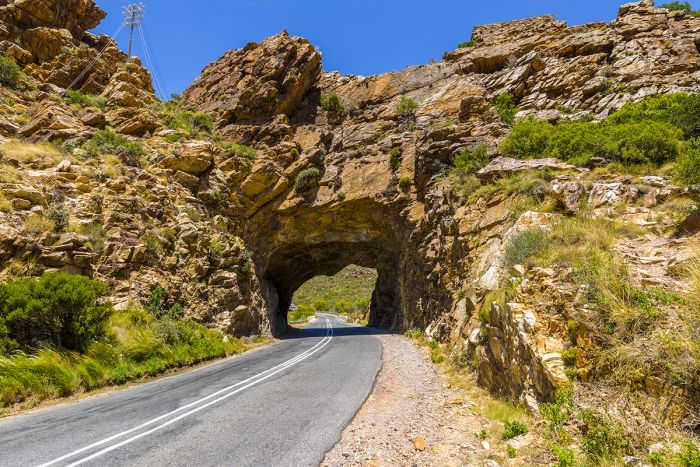
Mountain pass on road to Montagu
A popular alternative to driving the coastal N2 road into the Garden Route is to take the R62 through the mountains and the Little Karoo. Driving north from Robertson and through Kogmanskloof Pass in the Langeberg Mountains takes you to the town of Montagu.
Montagu is best known for its fruit farming, especially peaches and apricots, and its natural hot springs. The town is often called the Gateway to the Little Karoo. The town was founded in 1851 and has some lovely and historic Victorian architecture, some of which are now guesthouses and B&Bs. The Montagu Springs Resort is the town's main attraction and offers open-air hot springs situated at the base of spectacular cliffs.
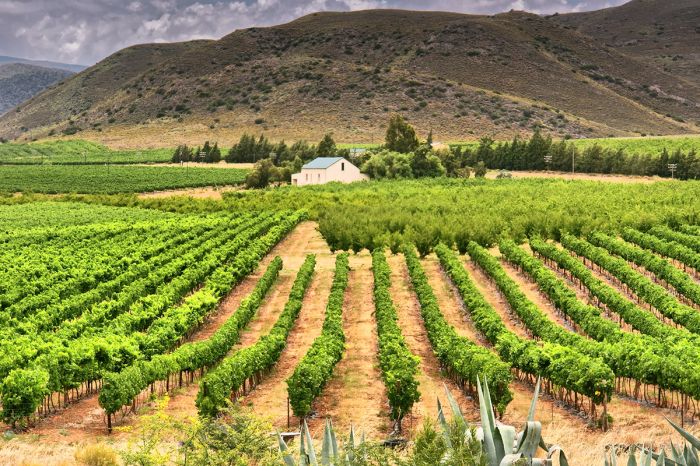
Vineyard near Montagu, South Africa
The 37-mile (60-km) drive along the R62 east from Montagu to the small town of Barrydale offers some of the most beautiful mountain scenery in the region. The route to Barrydale from Swellendam north through the Tradouw Pass is equally spectacular. Barrydale itself is a small, rural community with livestock, peach and fig farms.
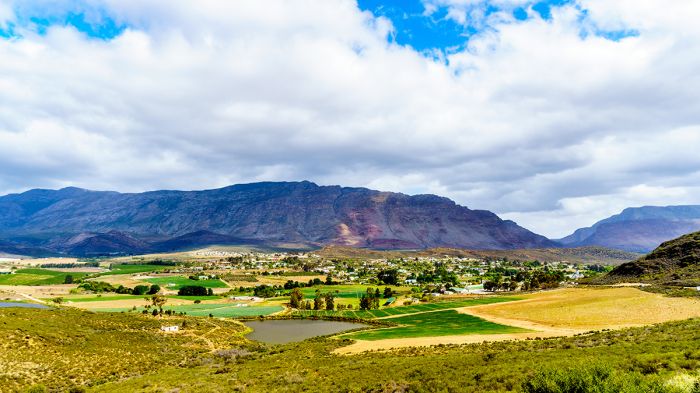
View over Barrydale from the R62 roadway
Just north of Barrydale is the 224-sq-mile (580-sq-km) malaria-free Sanbona Wildlife Reserve. The reserve is a joint cooperative between over twenty privately-owned farms set in a dramatic semi-desert landscape, with desert plains, mountains, gorges, cliffs, and the Brak river. Sanbona is the only place in the Western Cape with free-roaming lions and cheetahs. All of the Big Five (lion, leopard, elephant, rhino, buffalo) can be seen here, as well as myriad other species. Sanbona has three all-inclusive lodges plus a camping option.
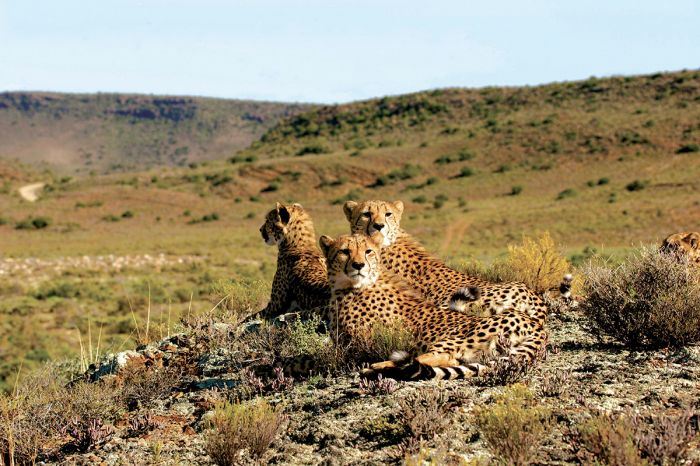
Cheetahs in the Sanbona Wildlife Reserve
Read More...
Arniston, Bontebok NP, Breede River Valley, Cape Agulhas, De Hoop, Gansbaai, Hemel-en-Aarde, Hermanus, Little Karoo, Montagu, Overberg, Robertson, Sanbona, Sharks, Swellendam, Whale Coast, Wineries-Breede River, Wineries-Hermanus, Worcester
Great Good Fair Poor
- Jan
- Feb
- Mar
- Apr
- May
- Jun
- Jul
- Aug
- Sep
- Oct
- Nov
- Dec
The Whale Coast lacks the distinct seasonal rainfall that is prevalent throughout much of South Africa and rains along the Overberg coast can occur at any time throughout the year. The coastal weather is pleasant all year, but temps and rains can be unpredictable, so it is advised to bring appropriate clothing regardless of the month.
The resort towns, especially Hermanus, become more crowded during the summer months (December thru January) and especially during the end of year holiday season.
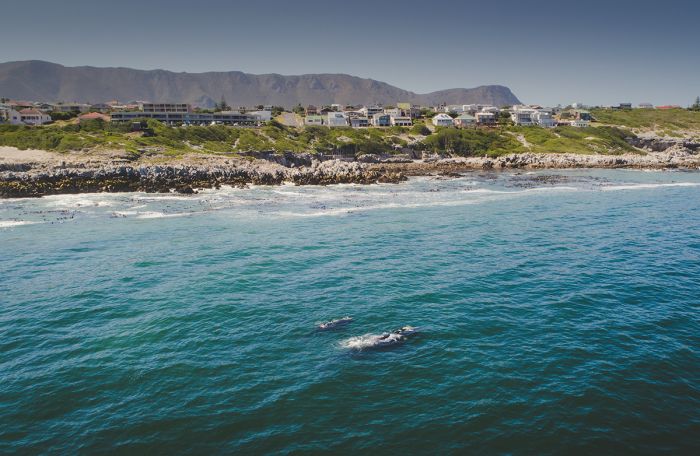
A southern right whale and her calf, Hermanus coast
Whale watching along the coast is best between July and October, when whales come to the region to breed and have their young. September and October the peak months for sightings. The Hermanus Whale Festival takes place during the last week of September.
Great white shark viewing at Dyer Island and around Gansbaai is best between June and September, as the water visibility is at its best and shark numbers are high.
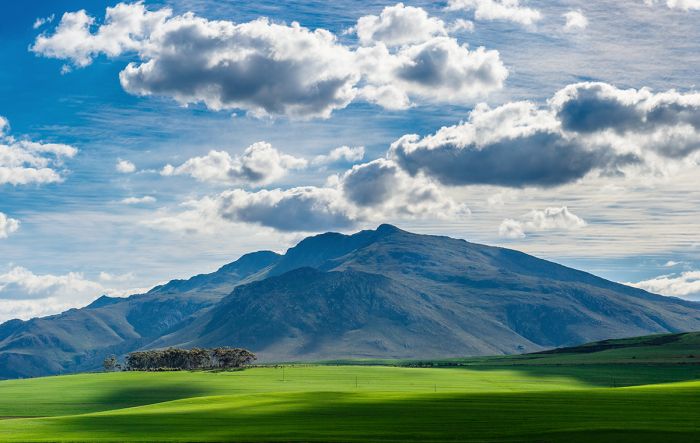
View of the Riviersonderend Mountains
The Breede River Valley experiences wonderful weather year-round, with warm, dry summers and mild winters. Rains are more likely during the winter.
The Little Karoo region is quite hot during the summer months of November thru March, but the nights are cool and comfortable. Little Karoo winters are lovely, with sunny and warm days, but nights are quite cold.
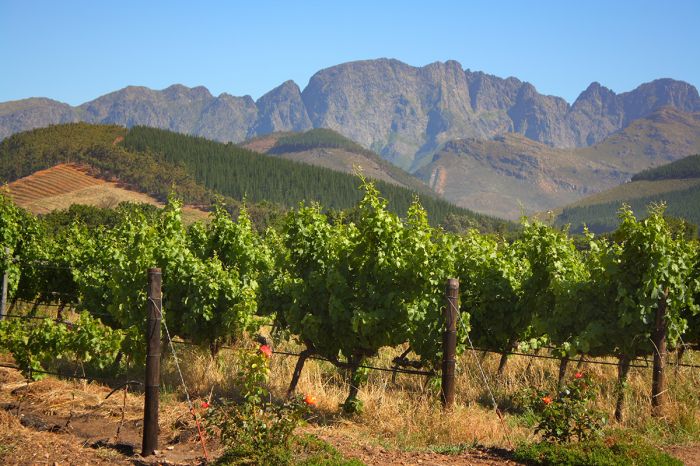
Wine grapes and the Langeberg Mountains near Montagu




